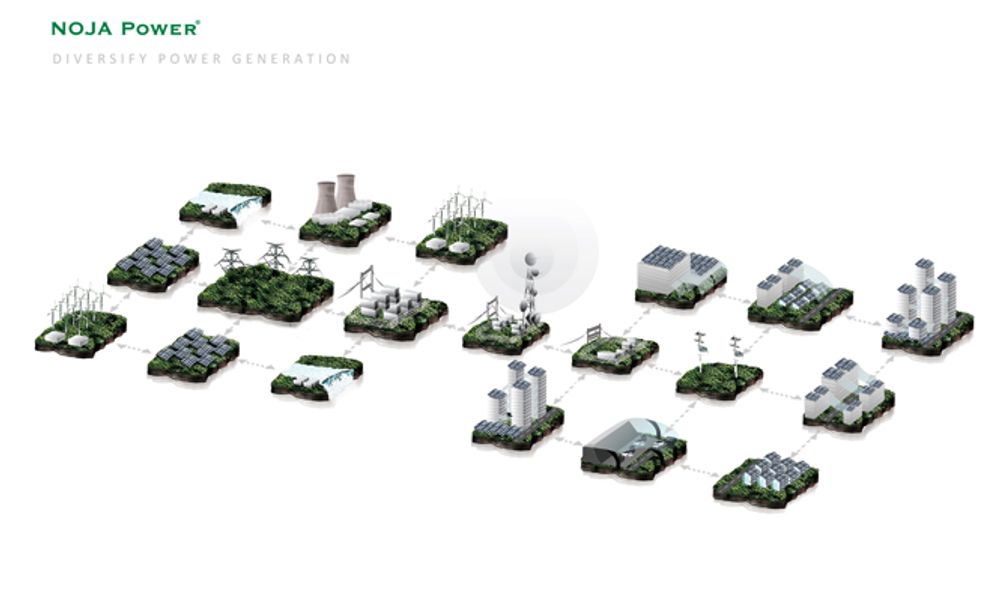Press Release
Published 03/2013
Carbon Emission Reductions by the Implementation of a Smart Grid
Automatic circuit reclosers enable cheaper construction of bidirectional electricity distribution lines essential to the implementation of a smart grid. device without having to climb the pole

Electrical switchgear engineers NOJA Power today highlights the essential role played by automatic circuit reclosers (ACR) in enhancing the electricity grid to ease the connection of diversified energy resources and help utilities lower their carbon emissions.
Traditional electricity systems are planned around a strategy that ensures that power generation is sufficient to comfortably meet peaks in demand with an additional margin to guarantee security of supply. At other times, and especially at night when demand is low, much of the capacity of the grid lies unused yet large generators––which can’t be stopped and restarted quickly––continue to run and emit carbon.
Smart grids are a new, more intelligent way of supplying electricity combining computerisation, digital communications, sensing and metering of the electricity network to create a bidirectional, interactive grid that encourages greater use of renewable energy sources.
Smart grids equipped with ACRs allow the connection of small generators using renewable energy sources such as solar, wind, geothermal, wave and tidal. A large installed base of renewable energy sources could provide utilities with the assurance that when one resource is unavailable due to, for example, lack of wind, another will be readily available to take its place. Combined with the ability to quickly switch the renewable resources into the grid using ACRs, this could reduce reliance on large, expensive, inefficient generation to meet peaks in demand.
According to the Australian Government’s Dept. of Climate Change and Energy Efficiency, the country’s carbon emissions were 580 megatonnes in 2012[1]. Of this, electrical power generation is estimated to be responsible for 35 percent of the country’s carbon emissions[2]. A fully implemented smart grid would reduce the electricity system’s carbon emissions by around 25 percent and overall emissions by 9 percent or 52 megatonnes per annum[3]. A reduction of this amount equates to a saving of almost AU$1.2 billion (at the 2012/13 price of AU$23 per tonne set under legislation introduced on 1 July 2012) for electricity generators and distributors covered by Australia’s carbon-pricing scheme.
“As a standard distribution automation device, ACRs allow electricity distributors to make cost-effective enhancements to ‘smarten’ its infrastructure while avoiding the expense and risk of ‘over-engineering’ associated with custom solutions,” says Neil O’Sullivan, Managing Director of NOJA Power. “These enhancements––especially when they improve the grid’s reliability and reduce the frequency and duration of outages––are vital for ensuring transmission and distribution infrastructure is able to cope with future demand.
“ACRs are fundamental building blocks for smart grids,” continues O’Sullivan. “The ability of reclosers to help utilities closely match supply and demand, rapidly switch in renewable energy sources and protect the grid is essential if the high efficiency and reduction in carbon emissions that the smart grids promise are to be realised.”
Units from NOJA Power's OSM range of medium-voltage (15, 27 and 38 kV) ACRs have been installed by utilities in over 80 countries around the world. The ACRs have been subjected to full type testing by independent test laboratories, such as KEMA in the Netherlands, to the latest standards. NOJA Power’s ACRs use solid dielectrics, replacing the environmentally-unfriendly oil or sulphur hexafluoride (SF6) gas of older products.
NOJA Power has produced a white paper detailing how automatic reclosers and other distribution automation (DA) devices enable smart grids and reduce the emissions of greenhouse gases in electricity generation, transmission and distribution.
Download White PaperReferences:
1. http://www.climatechange.gov.au/en/government/reduce/national-targets/fa...
2. “The Garnaut Climate Change Review: Final Report”, R. Garnaut, 2008.3. “An Australian Smart Electric Grid – Critical infrastructure for addressing global warming”, Telecommunications Journal of Australia. Brendan Herron, CURRENT Group, LLC, 2009.
Want to stay up to date with Electrical Distribution Technology?
Join our list for a free weekly technical bulletin, as we share our Global Electrical Engineering experience directly to your inbox.
Subscribe →